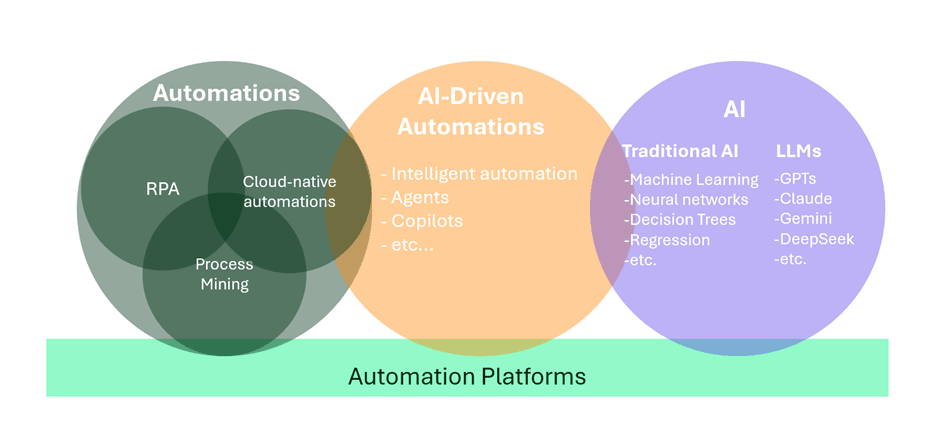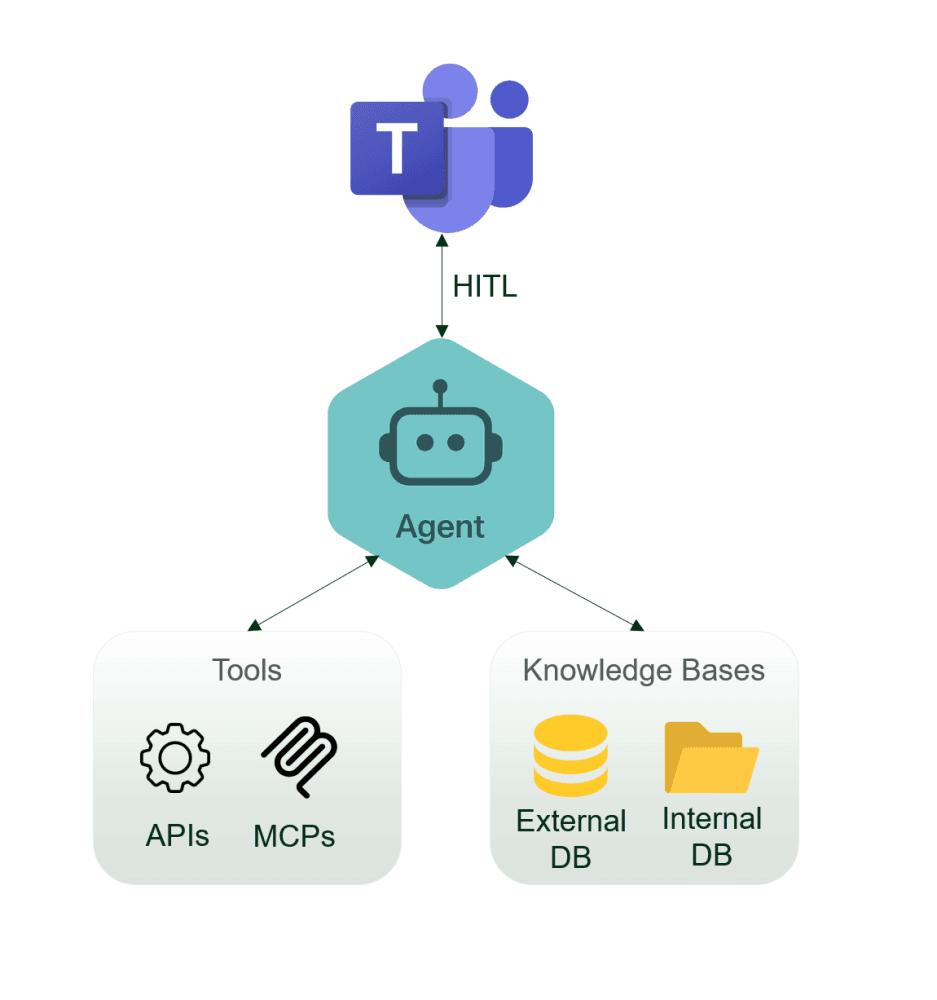Yes, AI Is Changing Automation – No, You’re Not Behind

First it was all Copilots, Copilots, Copilots. Then came the Agents, Agents, Agents wave. And now the latest hype seems to be MCP Servers, MCP Servers, MCP Servers. Things are moving fast in the AI and automation field. That is clear. AI is coming at us from every direction, and with it, a flood of new terminology. We’ve got intelligent automation, autonomous agents, cognitive automation, copilots, agents, agent flows, agent loops, AI Foundry… You name it.
I’m pretty sure both consultant and customer organizations have had their hands full just trying to keep up with all the new tools and terms. Personally, I can admit, that I feel a bit lost about what’s going on or which technologies we should be using right now in this rapidly changing phase.
Despite the chaos, I’ll try to take a small step back in this post and give a bit of clarity: what has actually changed, and what do “AI-Driven Automations” mean right now?

In the image above, I illustrate how we’re moving from traditional automations toward AI-driven ones. The goal has always been the same throughout IT history: make work more efficient by automating it. That’s done using automation tools, such as cloud-native automation platforms (e.g. Power Automate) or RPA-based tools (e.g. Power Automate Desktop).
Now, when we start combining these automations with AI capabilities, either with just classic regression models etc. or the newer LLM-based solutions, we get what I refer as “AI-Driven Automations.” This is where all the trendy new names like agents, copilots, intelligent automations, and autonomous automations start popping up.
What has actually changed in the world of automation?
The answer is LLMs. Large Language Models blew the whole thing wide open. We realized LLMs aren’t just fun chatbots like ChatGPT. They can actually bring in a whole new way of doing app development and automation.
Complex automations have always required long reasoning chains to function well. Now, some of that reasoning can be handed over to language models. For example, in customer service, an LLM can easily parse incoming emails, identify ordered products and their quantities, and generate machine-readable JSON out of it. So the LLM can handle some of the core logic for completing tasks.
But here’s where it gets interesting: LLMs can also be used to orchestrate automation flows. Basically, you define a knowledge base for your automation, and provide access to tools (APIs, MCP Servers, etc.). The language model is then responsible for using that knowledge and choosing the right tool for each situation based on the user’s prompt.
And that is what we now call an agent. I tried to simplify this idea in the image below.

This also marks an architectural shift. Where we used to build long, rule-based chains for automations, now we can drop those and let the LLM figure it out. Naturally, this raises concerns: can you really trust an AI to make those decisions? What about security risks when operating under this architecture?
Not everything needs to (or should) be done with AI
Unpredictability. That’s the new factor developers need to account for. With LLMs, we need to build safeguards into our automations, especially when they deal with external users or sensitive data. How do we make sure someone doesn’t sneak in a prompt (think prompt injection, like a SQL injection) that exposes data that was never meant to be public? Can the agent hallucinate? How do we make sure the data going into the process is valid? And does the agent always choose the right tool from its set?
Even if everything works perfectly in testing, edge cases will happen. This is something we must pay attention to, even if it’s tempting to just rush ahead with all the exciting possibilities AI brings.
In addition to unpredictability, here’s a basic sanity check that’s worth doing early on: Does this process really need AI at all? It’s not the first time I’ve seen a customer ask for an AI-based solution just to fetch and display data from source systems. And sometimes I must be the bearer of ”bad news” – a simple SQL query plus Power BI report is often more than enough. That said, I might still use AI to help in generating the SQL query, so yes, AI is still part of the picture, one way or another.
So what’s happening in the automation market right now?
AI has already brought (and will continue to bring) a big shift to both automation and software development – no question about it. But we’re also seeing that traditional automation still has its place. A lot of processes don’t need any AI to work well. What AI has done is bring automation back into focus. People are paying attention to it again. And that’s great, whether AI is involved or not.
If you scroll through LinkedIn, you might get the feeling that other companies are way ahead, squeezing all the value out of AI and building wild automations left and right. Don’t worry. That’s not really the case. There’s still a lot of work to be done. And no, you haven’t missed the train. Things are moving so fast in tech that even today’s AI-based automations might need to be rebuilt next year. You might even get a smoother ride by jumping in now.
It’s still too early to say which technologies will “win” in AI automation. I personally don’t believe there’ll be one AI to rule them all. It’s probably better for organizations to use a mix of tools, each with its own strengths. Even just looking at Microsoft’s current AI offering, there’s already a lot to digest in terms of which tool to use and when. That’s where we try to help our clients.
The automation market is hot right now. We’ve also been doing several migrations lately, e.g. moving clients from platforms like UiPath and BluePrism into Microsoft Power Platform. Power Platform isn’t always immediately seen as an automation platform, even though it has extensive automation capabilities. It’s often viewed mainly as an app development tool or only used for its data tools like Power BI. But Power Platform includes Power Automate and a bunch of other tools for building automations, and when those reach their limits, Azure can step in.
A few trends we’re seeing in the automation space:
- ChatGPT and Copilots are already part of everyday work
- Custom Copilots using an organization’s own data (RAG retrieval augmented generation) are a very common use case, often with a chatbot UI
- Projects have focus on data quality, too. We’re seeing increased interest in data warehouses (i.e. MS Fabric) that will be used in AI-Driven automations.
- The ROI from automations is unclear. Time and effort are saved, but this doesn’t always translate clearly into profits
- In some cases, the actual goal is headcount reduction (yes, AI is already taking some jobs 😬)
- Many organizations don’t yet have clear AI usage guidelines
- AI security is not being taken seriously enough
- The role of the user interface is changing: the focus is shifting more toward background processes and integrations, as direct user interaction decreases
What should you consider in automation projects today?
One of the biggest mistakes in automation projects is jumping straight into automating a complex process without asking: Should we rethink this process first? Often, it’s a case of “this is how we’ve always done it.” And even if the process is documented, that doesn’t mean that’s how it really works in practice. If you don’t map out what’s really happening, your automation project will struggle.
Also, if your organization is just getting started with automation, there’s often a temptation to start with something big and complex. My advice? Start small. That way you learn how the tools work, gain hands-on experience, and understand what modern automation really involves. There’s a common “magic bullet” expectation with automation, and when that doesn’t materialize, people get disappointed. So start small, build up your experience, then scale up to the bigger, complex stuff.
How can Forward Forever help you
At Forward Forever, we’ve been doing automations with Power Platform since Power Automate first launched. We want to bring concrete value to our clients. Cutting through the hype to help identify what’s relevant and what kinds of use cases are actually good targets for automation, with or without the help of AI. We also help with Power Platform Governance, so your platform setup is secure, scalable, and ready to adapt quickly to new tech.
Got an interesting automation case in mind? Want to talk about how Microsoft tools could help you build a scalable automation architecture? Drop us a message or ping me on LinkedIn.